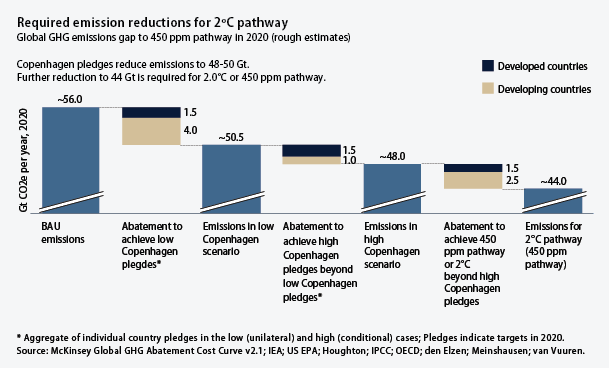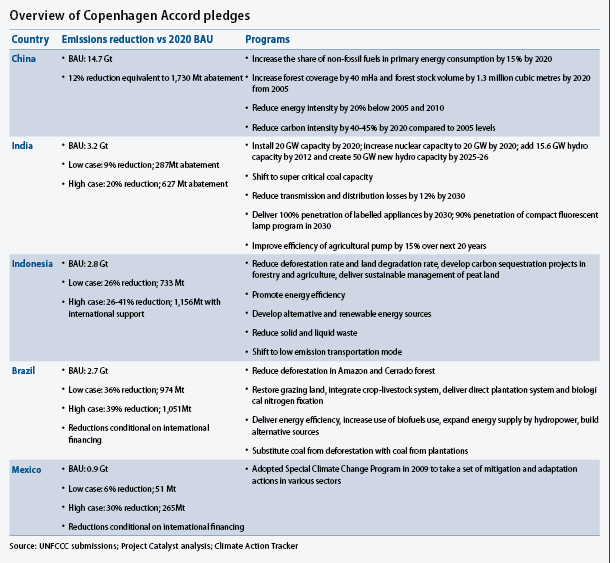Representatives from 194 countries gather this week in Cancun, Mexico, for the 16th meeting of the Conference of the Parties of the United Nations Framework Convention on Climate Change, or UNFCCC. The meeting will run through Dec. 10 and, predictably, pull an emergency session all-nighter through to Dec. 11 — though to what end no one knows for certain. This is the body that succeeded in Copenhagen last year in crafting a nonbinding political agreement, the Copenhagen Accord, that could serve as the foundation for creating a new binding climate treaty to either replace or complement the Kyoto Protocol. The Kyoto Protocol — also created by the UNFCCC — is currently the only binding global agreement for limiting carbon emissions. Its “first commitment period” for signatory parties requiring emission reductions will expire in 2012.
Despite the fact that five countries — Venezuela, Bolivia, Cuba, Nicaragua, and the Sudan — used their veto in this body’s consensus process to block the Copenhagen Accord as an official U.N. Framework Convention decision, approximately 138 countries aligned themselves with it and submitted pledges for greenhouse gas, or GHG, mitigation by the end of last January. Included in this group were the 17 largest emitters in the world responsible for 80 percent of carbon pollution.
After a long year of negotiating, the parties now reconvene for another bite at the apple. Chances for a big success, such as final ratification of the Copenhagen Accord or a new legally binding treaty, approach zero. But we could see significant progress on smaller but nonetheless critically important parts of a larger deal, such as so-called “sectoral agreements,” which are essentially smaller parts of what we would want to see in a comprehensive treaty, such as an agreement on limiting emissions from deforestation or an agreement on how intellectual property would be treated in the transfer of low-carbon technology from rich to poor countries.
Emission reduction pledges to date
To understand what could happen in Cancun, it’s first important to know where we are currently in international climate negotiations and national pledges to reduce emissions. In the final run-up to Copenhagen last year, the world experienced a dramatic period where some of the most important players joined parties like the European Union in finally announcing their commitments to reduce emissions by 2020. Most critical to the process were countries like the United States, China, and India, which either by design or by choice are not bound to reducing emissions under the Kyoto Protocol. Without the active participation of such countries it is impossible to get to climate safety. But how significant were these pledges?
Before the Copenhagen meeting started last year, the Center for American Progress initiated our “carbon cap equivalents” project. Working with Project Catalyst, we started tracking the national commitments of all the major GHG emitters to try to assess how close those policies and pledges, if enacted, would get us to a 2020 stabilization pathway that had a decent chance of holding temperature increase to 3.6 degrees F. (Holding temperature increase at 3.6 degrees is largely but not universally agreed as the best-case scenario for what can be achieved by collective global climate action at this time. It is the temperature goal stipulated in the Copenhagen Accord, though there is a requirement to investigate the possibility of stabilization at 1.5 degrees C (2.7 degrees F) at a later date.)
We found that even prior to the Copenhagen climate summit, if all parties did everything they claimed they would do at the time, the world was only five gigatons of annual emissions shy of the estimated 17 gigatons of carbon dioxide or CO2 equivalent annual reductions needed to put us on a reasonable 3.6 degrees F pathway. Since three gigatons of the projected reductions came from the economic downturn and improved projections on deforestation and peat emissions, the actual pledges of countries for additional reductions were slightly less than two-thirds of what was needed. But they were still not sufficient for the 3.6 degrees F target.
We need some kind of climate agreement to lock in the commitments that countries are willing to make — largely for reasons of self-interest — and to squeeze out of a system of cooperation additional reductions that can get us where we need to be to achieve some measure of climate safety.
After the Copenhagen Accord was finalized at the December 2009 climate summit, a January 2010 deadline was established for countries to submit pledges for actions by 2020 consistent with the accord’s 3.6 degrees F goal. Two breakdowns of the pledges in February, and later in March, by Project Catalyst estimated that the five-gigaton gap had shrunk somewhat and more pledges had come in from developing countries. Part of the reason that pledges increased from developing countries was that the Copenhagen Accord had finally made a significant step forward on establishing a system of cooperation between developed and developing countries that had a chance at providing incentives for additional reductions.
Most critical was an agreement on climate finance whereby donor countries would provide some developing countries with the assistance they need to make the transition to a low-carbon economy. Another crucial agreement helped to reconcile differences between various parties on expectations for measuring, reporting, and verifying promised mitigation actions, or MRVs.
As for the former, the accord created a commitment for $30 billion in “fast start” funding from 2010 to 2012 for developing countries, and it pledged to mobilize a climate fund of $100 billion annually by 2020. With these pledges in mind many developing countries made conditional pledges under the Copenhagen Accord, essentially promising a certain amount of reduction they would make on their own, which we call the “low Copenhagen scenario,” in our analysis with Project Catalyst, and a certain amount they would do with support — a “high Copenhagen scenario.”
As the Cancun meeting gets started these estimates look even better.

Now the five-gigaton annual emissions gap between the high Copenhagen scenario and a 3.6 degrees F pathway is down to four gigatons. And again, due to different estimates of where we are with business-as-usual, or BAU, emissions because of the economic downturn and other factors, the high Copenhagen scenario has us holding at two-thirds of where we need to be in terms of pledges to action.
Pledges, of course, are not what are needed but real programs on the ground that translate into real emission reductions. What we are getting now, though, is a concrete sense of what those programs will be with some of the largest carbon polluters, especially and perhaps most critically among the largest emerging economies. (See table.)

Each of these programs represents a concentrated and significant amount of work in each country. Insofar as those plans have been developed and some deployment has started, this should be sufficient to quell the complaints of those who continue to claim, erroneously, that countries
like China and India are doing nothing. In fact, at this stage, their policy planning on GHG mitigation is at least as advanced as that of the United States — if not more so.
State of the negotiations
If national policies are moving forward then the question becomes whether the negotiations are helping to take the next critical steps of forming cooperative efforts that assist national deployment and holding countries accountable for the pledges that they make.
Any close observer of the last year of international climate negotiations would conclude that it’s been a difficult time. Many of the Copenhagen Accord’s accomplishments, especially on finding a compromise between developed and developing countries on MRV, and other technical matters eroded over a long summer of negotiations where confidence in the accord did not show the resilience that many hoped to see. U.S. negotiators have expressed frustration about the inclination of some negotiators to walk back the positions that their leaders had negotiated personally in Copenhagen.
Nonetheless, progress has been made on other parts of the agreement, especially the initial delivery of the “fast start” financing. The United States managed to deliver $1.7 billion in fiscal year 2010, and the administration is aiming to deliver approximately $4 billion total by 2012. To help make the 2020 $100 billion climate fund a reality, the U.N. secretary general impaneled an advisory group on finance which produced a report released last month staking out the viability of various mechanisms that could be employed to meet the long-term climate finance goal.
Even so, many developing countries are understandably skeptical that the fund will move forward until they see more concrete steps to create it. On Monday, the Center for American Progress will release a report with several partner organizations identifying an interim strategy between 2012 and 2020 that might inspire more confidence in this process and create a new opportunity for U.S. leadership.
But as the Cancun summit turns to its more important second week of negotiations, the biggest source of concern to many will be how the United States will meet its commitments under the Copenhagen Accord of reducing emissions 17 percent below 2005 levels by 2020. The House of Representatives passed a comprehensive climate and energy bill last year, but the Senate was not able to complete the congressional package with a bill of its own.
Coupled with the results of the midterm elections, no one seriously thinks a comprehensive climate bill is in the offing anytime soon. While disappointing at home, this result is positively threatening abroad. If the world’s largest per-capita emitter is ultimately not able to deliver on its promised emission reductions under the Copenhagen Accord then other countries might well drop their commitments as well, endangering the possibility of a global climate agreement.
Yet there is some good news. A week and a half after the climate bill died in Congress last July, the United States firmly announced that its commitments under the Copenhagen Accord, and therefore its global commitments on climate change to date, remained in place. At the opening of an interim U.N. negotiating session in Bonn starting on Aug. 2, Jonathan Pershing, the U.S. deputy climate envoy, announced that the outcome at Cancun did not depend on passage of legislation and that the United States would still make good on its promises under the Copenhagen Accord by other means if necessary.
Pershing repeated this promise again in his opening press conference this past Monday saying, “We remain committed to President Obama’s pledge announced in Copenhagen last year for a reduction in GHG emissions in the range of 17 percent below 2005 levels by 2020.” When asked how they will deliver on this pledge, Pershing, Climate Envoy Todd Stern, and others point to executive authority for rule-making under the Clean Air Act through the Environmental Protection Agency, state action, and the possibility of passing less comprehensive legislation.
There have already been some reports suggesting that it will be very difficult for the United States to hit this mark without further legislation. Others see more potential in state programs than has been appreciated. Regardless, what is clear is that at some point either the United States must be able to present to the world an action plan for hitting its mitigation targets or else an independent system of review must be created that can provide assessment of the United States and all other international actors.
What to expect
What could emerge from Cancun, then, if we cannot expect a comprehensive agreement this time around? Again, the consensus view for some time has been that the best chance is on a series of smaller though not insignificant agreements on deforestation, technology transfer, and the architecture for a global climate fund. All of these would be valuable, especially deforestation, which globally accounts for the same total emissions as the entire transportation sector. It’s also one of the areas where donor countries like Norway have already launched game-changing programs of cooperation with recipient countries like Brazil and Indonesia with significant amounts of financing.
Throughout the year, however, the United States has insisted that it would not allow smaller pieces of an agreement to go forward, or, as Jonathan Pershing put it earlier in the week in Cancun, “Moving ahead on a few issues — deemed by some to be easy — while holding off on others — deemed by some to be difficult — is not be a path for success.”
The United States has particularly insisted on holding onto the gains that were made on the language of MRV in the Copenhagen Accord and expanding them. The essential position is that any progress on an agreement will be pointless if there is no way of verifying the emission reductions different parties promise to make. Unfortunately, the official negotiating text going into the Cancun meeting does not yet include substantive language that could satisfy all parties.
China and other developing countries have expressed strong reservations in the past that they should be bound by a system of MRV, especially for voluntary reductions in emissions that they take on themselves (such as the ones identified in the figure above in the “low Copenhagen scenario”) without financial or technical assistance from developed countries. The question that many are asking now is whether the United States will use lack of progress in this area to stop movement on smaller agreements on forestry and other areas.
The buzzword around the verification issue since the last interim negotiating session in Tianjin, China, ended in October has been “ICA,” or “International Consultation and Analysis.” Various systems of ICA have been discussed as a compromise position on MRV. The Indian government, among others, has been actively drafting language on what a system of ICA might look like focusing on how it could be used to assess progress that all parties make on emission reduction pledges regardless of the source of finance. One proposal would have actions by all parties subject to ICA and then apply a more stringent form of verification for projects designed to achieve emission reductions which are supported by a global climate fund.
Early reports from Cancun suggest t
hat the United States and China are showing signs of more agreement on the issue of measuring, reporting, and verifying emission reductions. If a proposal on ICA, or something else that could take that good will and turn it into an agreement, survives the meeting, it could ensure substantive agreements in other areas like forestry or technology transfer. If it does not, the meeting may end in a showdown between those who want to move forward on individual parts of a climate treaty and those who do not.
As with last year’s climate summit, however, I’ll be ready to blame the process rather than particular parties in the event that nothing emerges from this meeting other than an agreement to meet again next year. The UNFCCC’s consensus rule among 194 parties makes the U.S. Senate’s 60-vote threshold for action enviable. Failure to make any gains this year will only increase calls for more climate action in smaller forums like the G20 or the U.S.-led Major Economies Forum, which now brings together the 17 largest emitters in a series of regular discussions on proposals for clean technology cooperation.
These smaller venues might offer a better chance at coming to an agreement. But in doing so we will inherit an equally difficult problem: how to adequately represent the interests of the entire world into a process that won’t have all parties around the table. Let’s hope that the negotiators act in good faith to avoid such a predicament.



